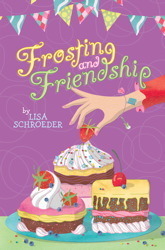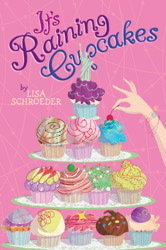Teachers Write 7/1/13 Mini-Lesson Monday with Lisa Schroeder
If you’re new here, Teachers Write is a virtual summer writing camp for teachers and librarians. Click here to sign up if you’d like to join us! If you’re on Facebook & want to also join our group there,here’s the link. Then click “Join Group.”
A quick note about blogging your Teachers Write experience: It’s GREAT if you want to set up a blog where you share all of your writing from this summer. One important request: Please do not copy and paste the mini-lessons or writing prompts – publish only your own writing on your blog. If you’d like to reference the ideas shared here, providing a link is the best way to do that. Thanks!

 Today’s guest author is Lisa Schroeder, who is the author of four teen verse novels including I Heart You, You Haunt Me and its companion, Chasing Brooklyn, Far From You, and the Oregon Book Award finalist, The Day Before. Her latest book for teens is a combination of prose and poetry, titled Falling For You. She’s also the author of the middle grade novels It’s Raining Cupcakes, Sprinkles and Secrets, and the forthcoming Frosting and Friendship (9/2013, Aladdin). Her books have been translated into several languages and have been selected for state reading lists. She lives in Oregon with her husband and two sons. You can learn more by visiting http://www.lisaschroederbooks.com.
Today’s guest author is Lisa Schroeder, who is the author of four teen verse novels including I Heart You, You Haunt Me and its companion, Chasing Brooklyn, Far From You, and the Oregon Book Award finalist, The Day Before. Her latest book for teens is a combination of prose and poetry, titled Falling For You. She’s also the author of the middle grade novels It’s Raining Cupcakes, Sprinkles and Secrets, and the forthcoming Frosting and Friendship (9/2013, Aladdin). Her books have been translated into several languages and have been selected for state reading lists. She lives in Oregon with her husband and two sons. You can learn more by visiting http://www.lisaschroederbooks.com.
Creating micro-tension in your novel
by Lisa Schroeder
You know the drill. When you’re writing a story, you have to figure out what your character wants and then put obstacles in his/her way (i.e. create conflict) in an effort to create an interesting journey for your readers to follow. Simply put, conflict = story. Of course, in great stories, there’s an internal journey as well as the external one.
So we try our best to keep that ultimate goal out there and keep our protagonist reaching for it. But according to agent and author Donald Maass, conflict must be present in small ways too. In his book, The Fire in Fiction, he says, “Keeping readers constantly in your grip comes from the steady application of something else altogether: Micro-tension. That is the tension that constantly keeps your reader wondering what will happen, not in the story, but in the next few seconds.”
Did you catch that? “Next few seconds.” I don’t think enough authors keep this in mind. I’d argue it’s even more important when writing for kids and teens because if they put a book down out of boredom, there’s a good chance it won’t get picked up again.
 So, let’s take a look at my middle grade novel, It’s Raining Cupcakes, because it’s one I obviously know well. The main character, Isabel, has never been out of the state of Oregon and she dreams of traveling. That’s her goal. But there are a few things keeping her dream from coming true. First of all, she’s a kid with limited income. Second of all, she has a mother who is afraid of flying. And finally, her parents are opening a cupcake shop, so travel is really the last thing they want to do. And yet, Isabel wants to travel. Badly. And she goes about trying to earn money and also enters a baking contest for kids because the finalists earn a trip to New York City for the bake-off.
So, let’s take a look at my middle grade novel, It’s Raining Cupcakes, because it’s one I obviously know well. The main character, Isabel, has never been out of the state of Oregon and she dreams of traveling. That’s her goal. But there are a few things keeping her dream from coming true. First of all, she’s a kid with limited income. Second of all, she has a mother who is afraid of flying. And finally, her parents are opening a cupcake shop, so travel is really the last thing they want to do. And yet, Isabel wants to travel. Badly. And she goes about trying to earn money and also enters a baking contest for kids because the finalists earn a trip to New York City for the bake-off.
In each scene where Isabel is trying to either raise money or come up with a recipe for the baking contest, I tried to create that magical and wonderful micro-tension. Let’s look at a couple of examples.
In one scene, Isabel is babysitting three-year-old twins in an effort to earn money. Of course, I let the little boys be boys, so it’s fun to read. But I knew I needed more than that to keep the reader engaged. Isabel notices some travel books in the house, and while the kiddy pool is filling up with water, Isabel decides she wants to read those books. She knows it’s not wise to leave the boys alone with the water, and tries to persuade them to go inside with her, but they refuse. So she tells them to stay out of the water, and off she goes. Here is an example of micro-tension. Suddenly, the reader is nervous. Will the boys get in the pool when Isabel steps away, even though she tells them not to? If they do get in the water, will one of them get hurt? And what if she gets caught?
In another scene, Isabel decides to try out a recipe for the baking contest she wants to enter. Her mom has told her she thinks she should enter a cupcake recipe. After all, if Isabel makes it to the finals, it could be good exposure for the new cupcake shop. But Isabel worries people might think her mom helped her. She really wants to do something different. But she doesn’t exactly tell her mom that. So one day, while her parents are both out running errands, Isabel attempts a recipe that isn’t a cupcake one. When Mom and Dad come home earlier than expected, Isabel panics. She grabs the dessert she’s just made and without thinking, runs out to the fire escape. Why the fire escape? Because as the author, I knew this was a great way to create some tension. I could have just had them come home and catch her in the kitchen, but why miss out on an opportunity for conflict? Once she’s on the fire escape, then what? Does she try to climb down? Does she throw the dessert out on the street? Will her parents catch her out there, hiding from them? And what happens when she realizes she just drank not one, but two root beers, and she suddenly has to go to the bathroom really, really bad? I put Isabel in a pickle, and that’s what me must do over and over again in our stories to keep the tension high.
One of the reasons The Hunger Games has been so successful, I’d argue, is because Suzanne Collins is a master at creating micro-tension. Of course, she set up a story that would be ripe for it, and kudos to her for doing that, but think how different the story would have been if it were just Katniss hiding in the woods, all by herself. With every character she encountered, there was tension.
Ask yourself, with each scene, what can you do to keep readers on the edge of their seat. Brainstorm a few different things, and then try them out and see how they play out on the page. As one author put it in this great blog post by Sarah Callender at “Writer’s Unboxed” (which I encourage you to read, because it’s another way of looking at micro-tension), “My characters must feel torn. Often. That’s right. We must create a massive game of tug-o-war within our characters by throwing choices in their direction. Even better, we might give them only lousy choices. Or, let them be torn and then let them make a wrong choice. We must make them squirm as a result of their choices. Squirming characters = engaged readers.”
Go on then. Have some fun. Make your characters squirm!
One lucky commenter today can win an Advanced Review Copy of Frosting and Friendship, a companion novel to It’s Raining Cupcakes and Frosting and Friendship.
Note from Kate: Thanks Lisa!! Remember, campers, in the comments, feel free to share a few lines of what you wrote today! Please note: If you’re a first-time commenter, I’ll have to approve your comment before it appears. This may take a while if I’m not at my computer, but don’t worry – I’ll get to it and it will show up later on! As we continue in writer’s camp, Gae and I are traveling on and off, so we won’t be able to reply to comments every day. But your guest authors may be stopping by, and you should most definitely read & reply to one another, too. Remember that it’s the community that makes this place so much fun!
And one last thing…Monday Morning Warm-Up is today, too!
.



